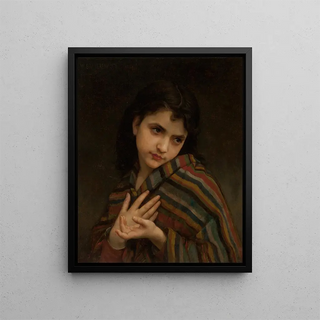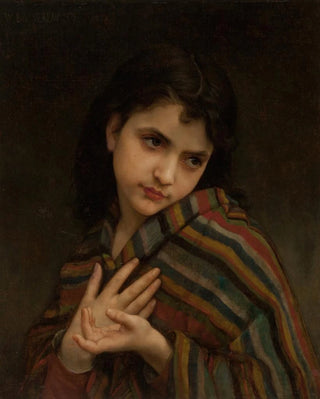Art print | La frileuse - William Bouguereau


View from behind

Frame (optional)
In the captivating world of academic painting, "La frileuse" by William Bouguereau stands out for its elegance and sensitivity. This artwork, created at the end of the 19th century, evokes a delicate atmosphere where feminine beauty is highlighted with impressive technical mastery. The scene depicts a young woman, draped in a light fabric, who seems to shiver under a gentle breeze. Her gaze, both thoughtful and melancholic, captures attention and invites contemplation. The composition, with its subtle use of light and shadow, creates an intimate ambiance that transports the viewer to a moment of tenderness and vulnerability.
Style and uniqueness of the work
Bouguereau's style is characterized by striking realism, where every detail is carefully crafted to create an illusion of life. In "La frileuse," the textures of the fabrics and the finesse of the young woman's features demonstrate impeccable technique. The artist skillfully plays with contrasts of light to emphasize volumes and add depth to the scene. The color palette, soft and harmonious, contributes to the dreamlike atmosphere of the piece. Bouguereau manages to capture not only the physical beauty of his model but also a palpable emotion, rendering the painting highly expressive. This blend of realism and poetry makes "La frileuse" an emblematic work of its time, reflecting the importance of emotion in art.
The artist and his influence
William Bouguereau, a major figure of the academic movement, established himself as one of the most respected painters of his era. Trained at the École des Beaux-Arts in Paris, he developed a unique style that combines tradition and innovation. His works, often centered on themes of daily life and the female condition, influenced many contemporary and later artists. Bouguereau was also a passionate defender of academic art in the face of emerging Impressionist movements, affirming the value of technique and craftsmanship. His impact on art history is undeniable, and "La frileuse" remains a testament to his mastery and influence.

Matte finish

View from behind

Frame (optional)
In the captivating world of academic painting, "La frileuse" by William Bouguereau stands out for its elegance and sensitivity. This artwork, created at the end of the 19th century, evokes a delicate atmosphere where feminine beauty is highlighted with impressive technical mastery. The scene depicts a young woman, draped in a light fabric, who seems to shiver under a gentle breeze. Her gaze, both thoughtful and melancholic, captures attention and invites contemplation. The composition, with its subtle use of light and shadow, creates an intimate ambiance that transports the viewer to a moment of tenderness and vulnerability.
Style and uniqueness of the work
Bouguereau's style is characterized by striking realism, where every detail is carefully crafted to create an illusion of life. In "La frileuse," the textures of the fabrics and the finesse of the young woman's features demonstrate impeccable technique. The artist skillfully plays with contrasts of light to emphasize volumes and add depth to the scene. The color palette, soft and harmonious, contributes to the dreamlike atmosphere of the piece. Bouguereau manages to capture not only the physical beauty of his model but also a palpable emotion, rendering the painting highly expressive. This blend of realism and poetry makes "La frileuse" an emblematic work of its time, reflecting the importance of emotion in art.
The artist and his influence
William Bouguereau, a major figure of the academic movement, established himself as one of the most respected painters of his era. Trained at the École des Beaux-Arts in Paris, he developed a unique style that combines tradition and innovation. His works, often centered on themes of daily life and the female condition, influenced many contemporary and later artists. Bouguereau was also a passionate defender of academic art in the face of emerging Impressionist movements, affirming the value of technique and craftsmanship. His impact on art history is undeniable, and "La frileuse" remains a testament to his mastery and influence.






